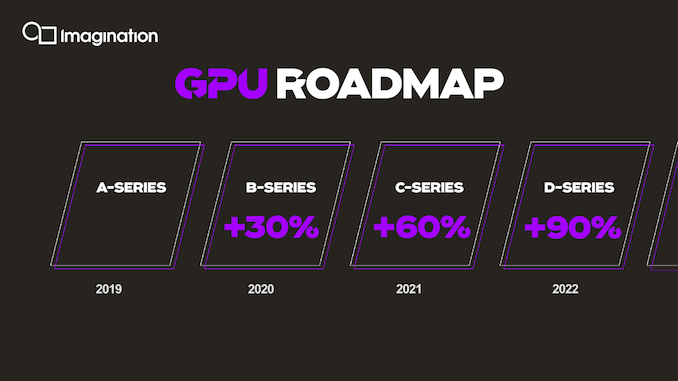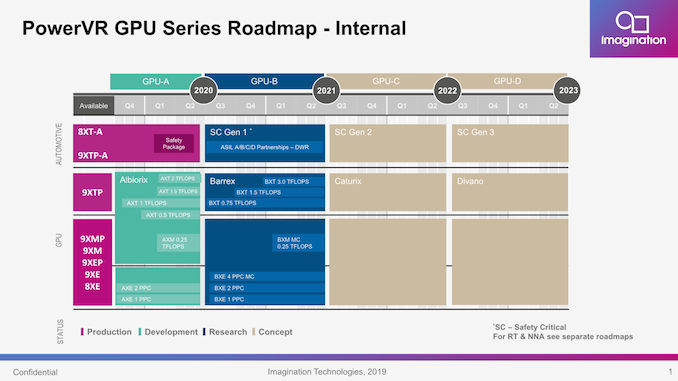Imagination Announces A-Series GPU Architecture: "Most Important Launch in 15 Years"
by Andrei Frumusanu on December 2, 2019 8:00 PM ESTFuture Roadmap & Final Thoughts
The new A-Series architecture means to represent a reset for Imagination’s product offerings, representing a bright new future for the company. The new GPU IP is certainly impressive in terms of the PPA metrics that it promises to achieve, and if realized, it does have ramifications for the wider industry and the competitive landscape.
But even if the A-series can deliver on all of Imagination's promises, the company can't stop there. The competition is continuing to refine and improve their designs, and so must Imagination. To that end, along with today's announcement of the A-series, Imagination is also publishing a very broad roadmap for the next few years, outlining the upcoming GPU generations and their expected performance gains. All of this is especially important for SoC designers, who want to know what's coming down the pipe before making the effort to switch IP vendors.
Imagination’s roadmap following the A-Series is seemingly very aggressive, promising yearly updates going forward, with large annual performance increases of 1.3x, or a 30% yearly compound annual growth rate. This is a much bigger goal than we’re used to historically, but it’s very much in line with the pace of progress we’ve seen from some vendors in the past, or even what Apple has managed to recently achieve over the last two generations.
For the A-Series, Imagination has adopted a public announcement schedule more similar to Arm’s, meaning that the A-Series has already been finished and licensed out to customers, with SoCs being designed and prepared to hit the market for 2020 – we’re assuming the latter part of 2020.
The B-Series is already well under way in terms of development and projected to be completed by next summer if the roadmap is to be taken as an accurate schedule, so at least Imagination has a strong path forward.
What’s important here for Imagination, is managing to actually achieve design wins for the new GPU IP in meaningful higher volume sockets. In terms of possible customers, it’s an increasingly small list, with most of them being the smaller Chinese SoC vendors such as RockChip, Unisoc (formerly Spreadtrum). Samsung is an unlikely client given their plans with AMD as well as custom GPU development, unless there happens to be some opportunity in the low and mid-range segments. HiSilicon likely is tied to Arm, if their plans of a custom GPU don’t pan out. This leaves MediaTek as one of the bigger clients, with the most opportunity and likelihood of adopting the A-Series. Holding onto more MediaTek SoC wins, instead of having them flip-flop between PowerVR and Mali, would be a big win for Imagination and its GPU group. With MediaTek now having re-entered the flagship SoC market, it seems like a very good match.
The wider semiconductor industry is said to be in an architecture revival phase, realizing the need for stronger designs in order to make up for decreasing yearly improvements in process performance. Imagination’s A-Series here seems to be a perfect example of such a revitalization, bringing with it massively impressive generational jumps. If the improvements pan out in practice, I do believe it could be a turning point for the company, and in the future we indeed might look back on it as being the most important launch in the company’s mobile history.












143 Comments
View All Comments
ET - Tuesday, December 3, 2019 - link
> I fear that this will be a very niche product unless it absolutely dominates all other solutions.At least from the description in the article, it seems to dominate Mali. Even next gen Mali. I don't expect Apple or Qualcomm to move. Samsung I think would be flexible. It's impossible to say how well RDNA fits all price points or when it will arrive, so ImgTech could find a place there. And with the A series supposedly much better than Mali in performance per silicon, I don't think that HiSilicon using it is totally out of the question.
Spunjji - Tuesday, December 3, 2019 - link
No reason HiSilicon can't change their minds if there's a compelling reason. PPA advantages directly translate into cost savings, which is very compelling indeed.MediaTek are probably going to be the biggest customer, though.
mode_13h - Wednesday, December 4, 2019 - link
Chinese want nothing to do with ARM, any more. Got it?So, anyone who's using Mali, or any Chinese phone makers who are using Qualcomm are potential customers.
vladx - Wednesday, December 4, 2019 - link
If you bothered to read the article, you would've found the answer but I guess Americans can't be bothered to read.s.yu - Wednesday, December 4, 2019 - link
"Americans can't be bothered to read"Wow, calling others haters, and look at you.
Etain05 - Tuesday, December 3, 2019 - link
I know that they don’t actually compete, since Apple will never offer its design for licensing, but I still think it’s interesting to compare them.Let’s take the numbers from the Huawei Mate 30 Pro review and compare making some assumptions.
Andrei says: “The comparison implementation here would be an AXT-16-512 implementation running at slightly lower than nominal clock and voltage (in order to match the performance).”
Let’s assume the AXT-16-512 is underclocked by 10% to get to the same performance as the Exynos 9820 and Snapdragon 855. Let’s also assume that an AXT-32-1024 is exactly double the performance of the AXT-16-512.
So, a nominally clocked AXT-16-512 would have 110% the performance of the Snapdragon 855 and Exynos 9820. Double that, and you get 220% the performance, for the AXT-32-1024.
Looking at the Huawei review, here are the numbers:
GFXBench Aztec Ruins High
Exynos 9820 and Snapdragon 855: ~16fps —> AXT-32-1024: 16fps + 120% = 35,2fps
Apple A13: 34fps
GFXBench Aztec Ruins Normal
Exynos 9820 and Snapdragon 855: ~40fps —> AXT-32-1024: 40fps + 120% = 88fps
Apple A13: 91fps
GFXBench Manhattan 3.1
Exynos 9820 and Snapdragon 855: ~69,5fps —> AXT-32-1024: 69,5fps + 120% = 153fps
Apple A13: 123,5fps
GFXBench T-Rex
Exynos 9820 and Snapdragon 855: ~167fps —> AXT-32-1024: 167fps + 120% = 367fps
Apple A13: 329fps
It seems that at least on performance (with generous assumptions), if the new architecture fulfils all promises, it would be competitive, even slightly better than the Apple A13. The problem is that it won’t compete with the A13, but the A14...
How did we get to Apple dominating GPUs too, so fast?
drexnx - Tuesday, December 3, 2019 - link
they're totally unafraid to spend as much die space as they need to get their performance scaling. look at a history of Ax die sizes and you'll see they're all over the placeSpunjji - Tuesday, December 3, 2019 - link
Agreed. It's their vertical integration at work - they're the only company prepared to spend that much die area on performance because they're the only company besides Samsung that can guarantee to sell all every chip they make in a high-end, high-margin device.Andrei Frumusanu - Tuesday, December 3, 2019 - link
Apple's GPUs are the second smallest in the space - only Qualcomm uses less die area.vladx - Wednesday, December 4, 2019 - link
When you extort your customers like Apple does, you can afford to design more expensive SoCs while still keeping huge profits.Apple is the biggest example of what a toxic system capitalism can become.